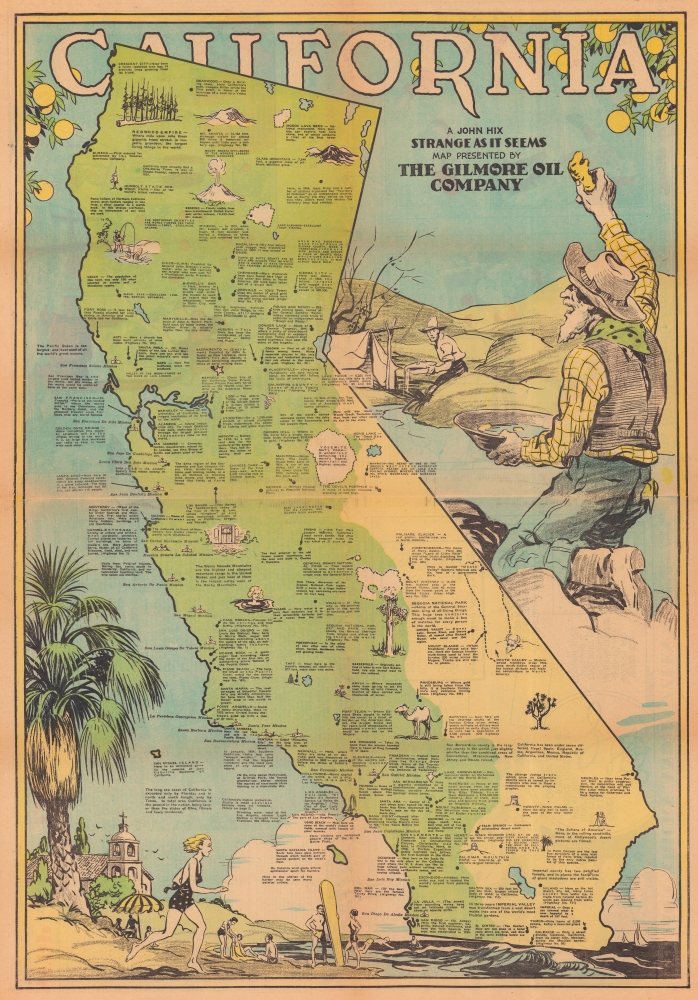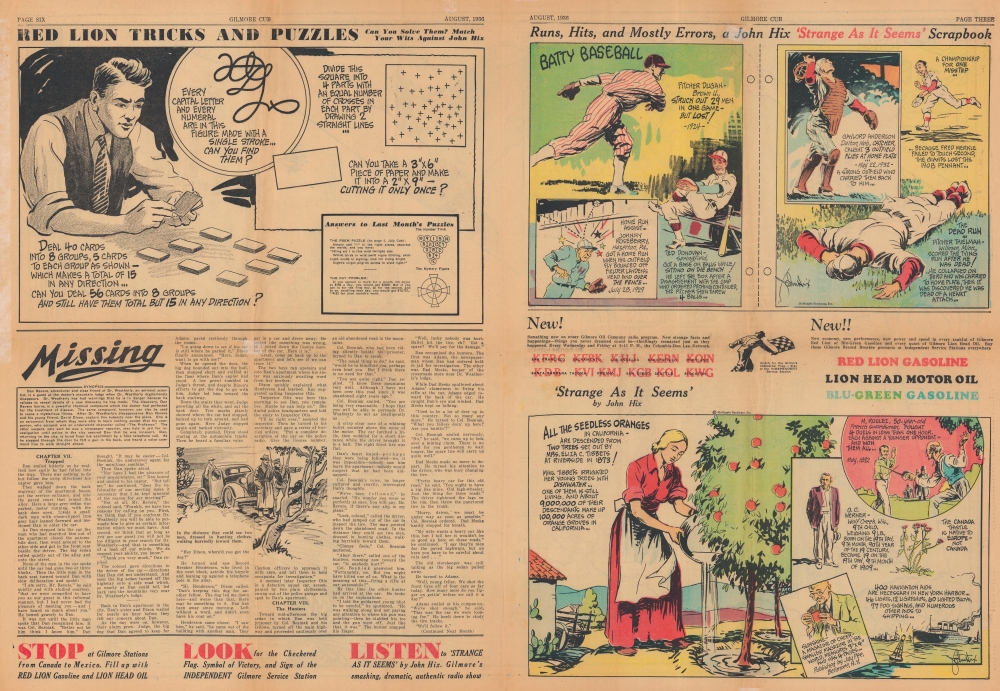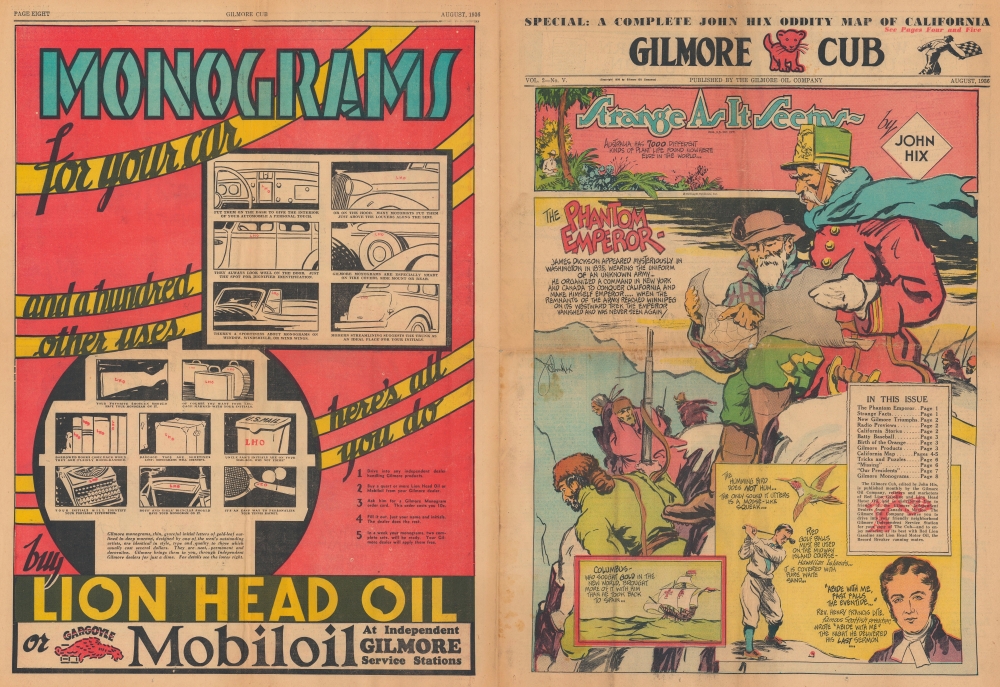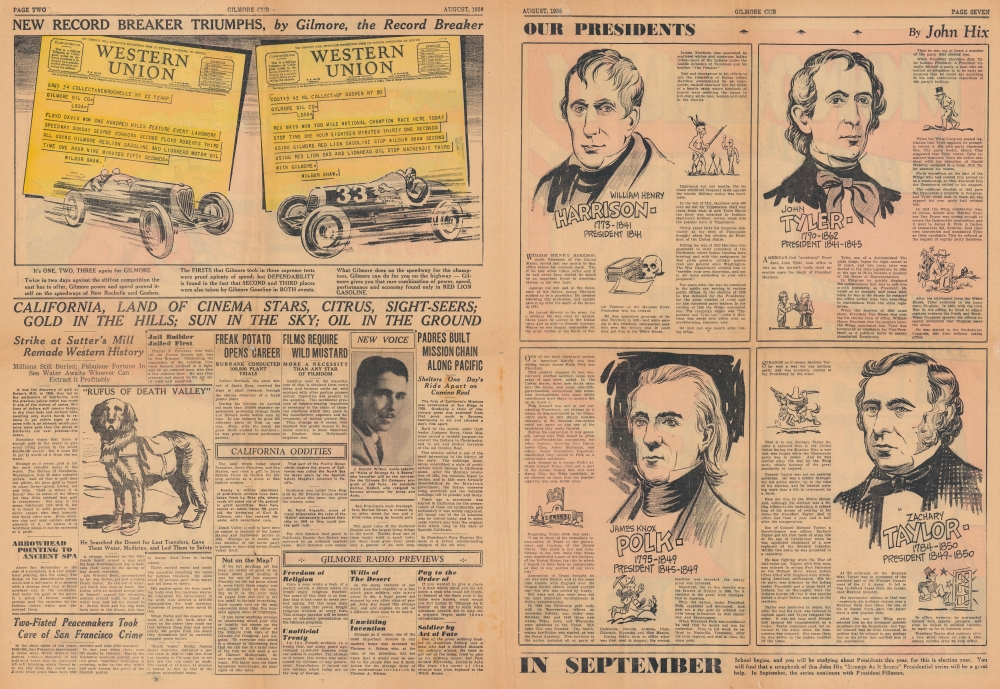This item has been sold, but you can get on the Waitlist to be notified if another example becomes available, or purchase a digital scan.
1936 John Hix Strange as it Seems Pictorial Map of California
California-hix-1936
Title
1936 (dated) 29 x 20 in (73.66 x 50.8 cm)
Description
A Closer Look
Pictorial vignettes and short captions populate the state. Both present charming and surprising facts about California's history, society, and culture. Some, such as 'Redwood Empire' or 'Yosemite National Park' emphasize California's natural beauty. Others, including the texts about San Francisco, Sacramento, and Monterey, provide information about California's founding. Many highlight the Gold Rush, a fact underlined by the impressive vignette in the upper right illustrating a prospector holding a massive gold nugget to the envy of his compatriot. A much more modern scene appears along the bottom border and highlights California as a beach destination.Strange as it Seems
John Hix created Strange as it Seems in 1927. It was a comic strip detailing outlandish facts akin to Ripley's Believe it or Not!. In contrast that competing publication, Hix insisted that his facts be verified by at least three sources. In each cartoon, he included the prompt, 'If you doubt this, write for proof to the author'. Several paragraphs of explanation usually accompanied the comics. In December 1927, Hix signed with the McClure Newspaper Syndicate, making him, at 20, the country's youngest nationally syndicated artist.Strange as it Seems debuted on March 28, 1928 in 50 newspapers. It consisted of a single panel featuring illustrations of unusual events, people, and places. The comic expanded to a full-page full-color edition in Sunday newspapers in February 1930, when syndication expanded to 80 newspapers. In 1930, Ernest Hix (1902 - 1948), John's brother, became the comic's business manager, franchising the brand into movie shorts produced by Universal Studios - a move to compete with Ripley's, which began producing shorts through Paramount earlier in 1930. The Strange as it Seems shorts were screened at over 6,000 theaters nationwide.
A hardback edition of the cartoons was published in 1931 and Strange as it Seems was syndicated in over 150 newspapers by May 1932. It also began appearing in newspapers in China, England, and Japan. The cartoons made it onto the radio in the spring of 1935, when Hix translated them into 15-minute radio programs. This became a 30-minute program in September 1939, and aired on CBS for seventy-two weeks.
Ripley's Believe it or Not! opened an exhibit at the California Pacific International Exposition in San Diego in May 1935, but their exhibit was deemed 'too gruesome'. Hix and Strange as it Seems were contacted by the organizers to take Ripley's place for the 1936 season. For the 1939 New York World's Fair, Hix and his brother opened a similar exhibit, outmaneuvering Ripley's. At its height, Strange as it Seems was syndicated in over 1,300 newspapers. Hix worked with the Office of Emergency Management during World War II (1939 - 1945), incorporating 70 ideas into Strange as it Seems comics to help the war effort.
John Hix died on June 6, 1944. Following his death, his brother Ernest took over the business until he died in a private plane crash on September 18, 1948. After Ernest's death, his wife Elsie Elizabeth (Huber) Hix ran the business and wrote the comic strip until 1963, when she handed the business over to her son Ernest Harmon Hix Jr., who produced the comic with his wife Phyllis until it ended in 1970.
Publication History and Census
This map was created by John Hix and published in the August 1936 issue of the Gilmore Cub, a short magazine published by the Gilmore Oil Company. This is the only known cataloged example.Cartographer
John McCary Hix (Jun 17, 1907 - June 6, 1944) was an American cartoonist, filmmaker, and author. Born in Huntsville, Alabama, Hix's family moved regularly. Between his birth and 1918, the family lived in Nashville, Tennessee; Spartanburg, South Carolina; and Greenville, South Carolina. Hix developed an urge to draw at an early age, often creating unflattering caricatures of his teachers that regularly got him in trouble. His drawings appeared in the Greenville High School newspaper, the Nautilus, and he was a staff artist for the Greenville Daily News while in high school. Since there was not an art school close by, he studied cartooning via correspondence course. Hix was a senior in high school when his father died on March 5, 1926, and graduated about two months later. After graduation he applied to be an editorial cartoonist for the Washington Herald and got the job. This meant relocating to Washington, D.C., where he also took a few classes at the Corcoran School of Art. While in D.C. he started a one-column comic strip called Hicks by Hix that became popular and was eventually syndicated. This success earned him a position with McClure Newspapers in New York City where he illustrated Young Frank Merriwell, a new comic strip by Gilbert Patten. While in New York Hix attended a few classes at the National Academy of Design and dreamed of attending the Yale School of Art, where some of his classmates were students. Unfortunately, Hix could not afford to attend Yale, so his education was learned on the job. Hix created Strange as it Seems (a comic strip that featured outlandish facts akin to those in Ripley's Believe it or Not!) in 1927. Hix died on June 6, 1944, of a heart attack caused by myocarditis. He never married and did not father any children. More by this mapmaker...








